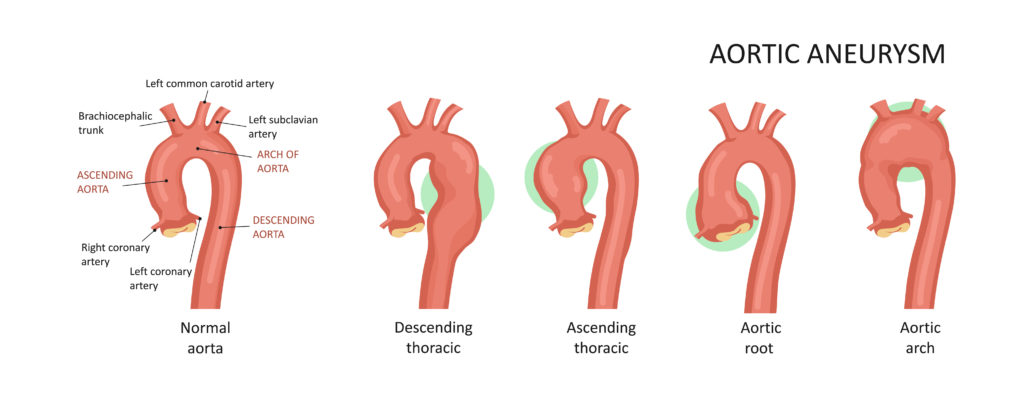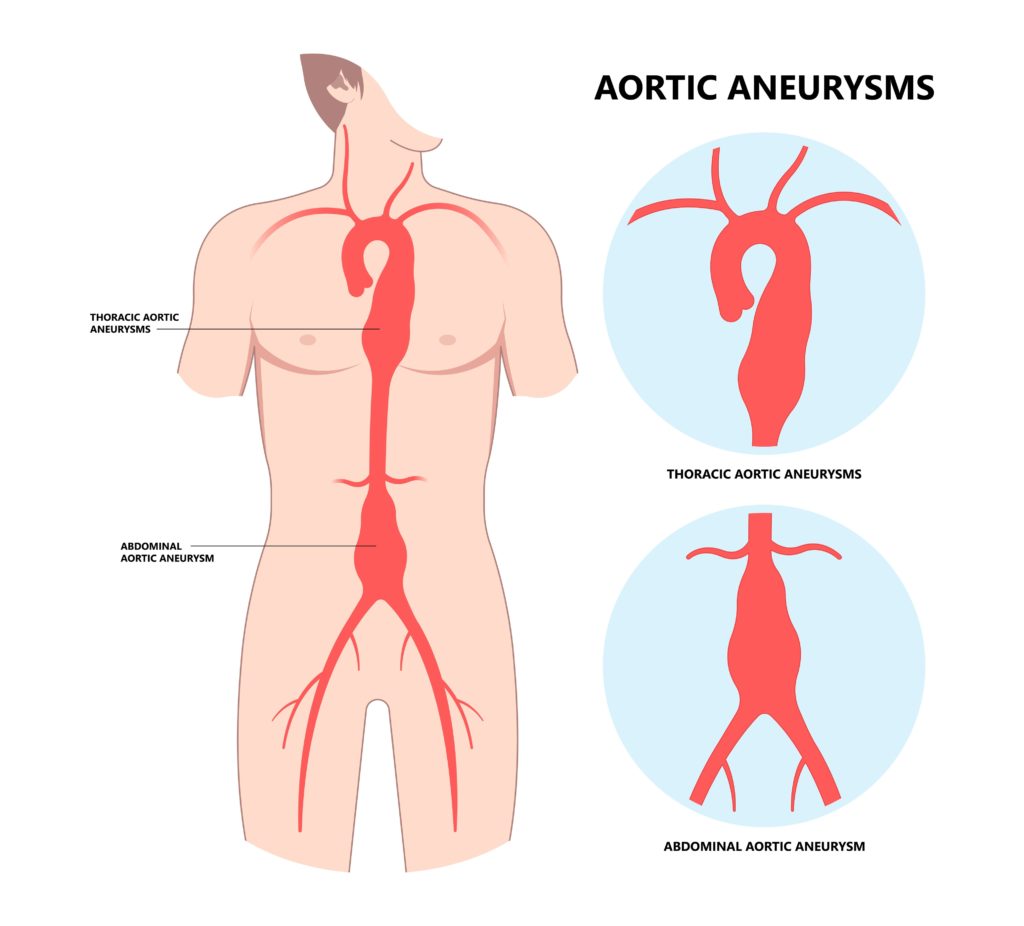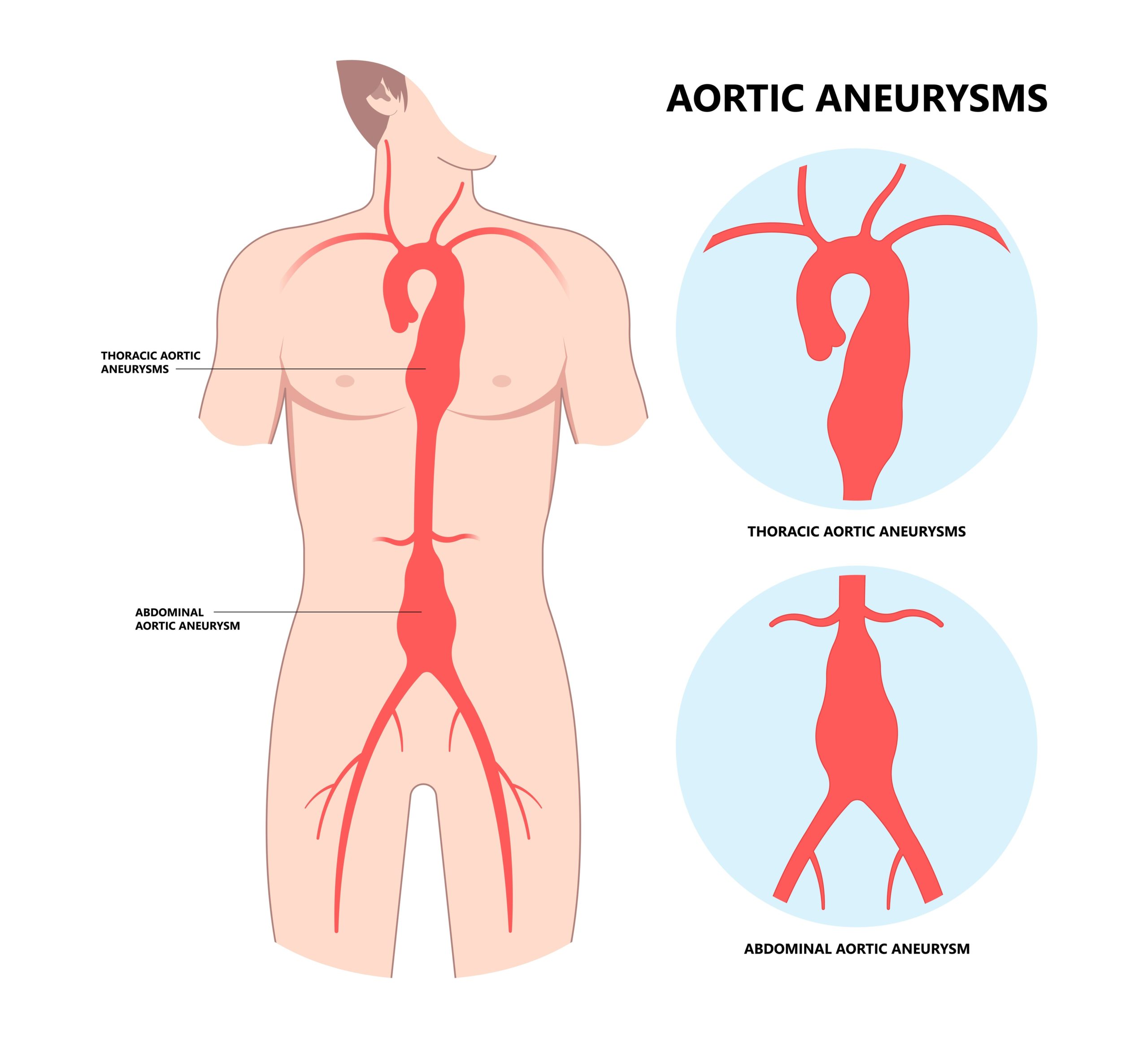Aortic dilatation, otherwise known as aortic root dilatation or aortic root, is an enlargement of one of the main heart valves that carry blood flow from the heart to the chest and torso. This valve is called the aortic valve, and when it becomes enlarged in this way there is an increased risk of it tearing or rupturing.
Aortic dilatation is considered a dangerous and life-threatening condition because it is a precursor to an aortic aneurysm, the complete rupture of this valve. The size of the dilatation matters when it comes to the risk of rupture, and is why close monitoring of the extent of dilation is crucial.
Fortunately, you can reduce the risk of this condition with proper diet, lifestyle, and prevention measures.
Keep reading to learn:
- What a dilated aortic root is
- Aortic dilatation causes and symptoms
- Diet recommendations for prevention and treatment
- Medical recommendations for prevention and treatment
What is Aortic Root Dilatation?
Aortic dilatation, or aortic root dilation, develops as a weak spot in the aorta, one of the main heart valves. The role of this valve is to pump blood out of the heart and into the chest and torso regions.
In aortic dilatation, a balloon-like structure forms as the aortic valve grows in this weak spot, increasing the risk of rupture or tear. It also can cause circulating blood to leak back into the heart, blocking blood flow and increasing the risk of blood clots.
The prevalence of aortic dilatation in the general population is more common than many would think. According to one study of hospitalized patients, 6.9% of the population had this condition.
However, it is much more common in certain populations based on age and other risk factors. For example, in those who are middle-aged or especially middle-aged men, the prevalence is as much as 30-70% depending on several risk factors. This risk was further increased in those who weighed more.
Aortic dilation often doesn’t cause any initial symptoms and is frequently detected on routine testing such as an echocardiogram or MRI. Typically once the dilatation has grown to a certain size, symptoms are more likely to occur.
According to research, an aortic diameter greater than 4 cm may increase the risk of rupture, however other factors are also at play such as age, weight, and other cardiac risk factors.
If aortic dilatation is detected and treated, it requires frequent monitoring.
If it grows large enough where a rupture occurs, it is called an aortic aneurysm and can be a life-threatening condition.

Causes of Dilated Aortic Root
There are several potential causes of aortic root dilation to be aware of. If you have any of these risk factors, consult with your doctor to get tested.
- Being overweight
- Smoking
- Being over 50 years old, especially men
- Family history
- High blood pressure
- High stroke volume (the volume of blood pumped with each heartbeat)
- High cholesterol and atherosclerosis (plaque build-up)
- Inflammatory conditions such as Takayasu’s, Marfan syndrome, Loeyz-Dietz syndrome, and giant cell arteritis
- Having a bicuspid aortic valve or connective tissue disorder
- Infections such as graft infection from a previous aneurysm repair (less common)
Fortunately, several of these risk factors are related to lifestyle and can be modified through working with a cardiac dietitian and medical team.
Aortic Root Dilation Symptoms
Here are the most common aortic root dilation symptoms to look out for. However, many times the condition is asymptomatic. Oftentimes the size of the dilatation dictates the extent of symptoms if any, where a larger sized dilation is more likely to cause symptoms.
Signs and symptoms to look out for:
- Chest pain
- Coughing/wheezing
- Shortness of breath
- Difficulty swallowing
- Hoarseness
- Upper back pain
An aortic dilatation can develop slowly and therefore exhibit no symptoms until it becomes larger or leads to an aneurysm. Because of this, it is crucial to schedule regular preventative health checkups with your doctor, especially if you are at an increased risk.

Aortic Dilatation Prevention and Treatment
Certain diet and lifestyle factors play a large role in dilated aortic root prevention and treatment. Here are some of the top prevention measures you can implement to lower your risk.
Prevention Measures
- Don’t smoke – Smoking is one of the most common risk factors for aortic dilatation, and in fact, may put you at an even higher risk than having atherosclerosis. If you are a smoker, quitting can significantly reduce your risk. For support to stop smoking, speak to your doctor about a smoking cessation program.
- Maintain a healthy weight – Being overweight is seen to be a risk factor for aortic dilation. Therefore losing even a modest amount of weight, such as 5% of your body weight, can improve your overall heart health and reduce your risk of aortic root. For example, one study showed weight loss reduced the aortic diameter which can lower the risk of aortic aneurysms. The type of diet and sustainability approach you use to help achieve these goals matters for optimal heart health.
- Eat a heart-healthy, nutritious diet – Consuming a nutrient-rich diet containing heart-healthy ingredients can support healthy blood pressure levels and reduce the risk of aortic root. Limiting potentially harmful ingredients for your heart is also equally essential.
- Limit sodium
Too much sodium in the diet increases the risk for many cardiovascular problems including blood pressure and heart disease. These conditions increase the risk for aortic dilation, and thus an essential first step is to limit sodium intake. Sodium is found in processed, packaged foods, cans, fast food, and is added at the table.
Always check the nutrition label for sodium content before purchasing, as many products contain more than you would think. The daily recommendation is to limit sodium intake to 2300 milligrams (mg) per day, as per the latest American Dietary Guidelines.
To meet this daily guideline, choose products with less than 300 milligrams of sodium per serving whenever possible.
- Focus on highly nutritious foods
Specifically, eating more potassium, calcium, and magnesium-containing foods helps to control blood pressure. These include heart-protecting foods such as beans, lentils, bananas, potatoes, squash, spinach, broccoli, avocado, low-fat dairy, nuts, and seeds. If you avoid many of these foods, working with a cardiac dietitian to help create a nutrient sufficient heart healthy diet can be helpful.
- Follow a heart-healthy diet to reduce risk factors
Make sure that all of your risk factors are optimally controlled through a research-driven heart healthy nutrient sufficient diet. This allows for better blood flow, less arterial stiffness, and less strain on the heart which can help reduce your risk of an aortic aneurysm.
- Manage blood pressure and cholesterol levels
Controlling blood pressure to a level of less than 120/80mmHg or as determined by your doctor and keeping LDL (the “bad” cholesterol) to less than 70 mg/dL with science based nutrition is also important to stabilize aortic dilation growth and possibly shrink it. These values need to be controlled not only in the short term but also in the long term, so long term implementation and habit formation is key.
As your cardiology dietitian, I guide you and create a personalized plan for you to reduce the risk factors associated with aortic root dilatation. All in all, there needs to be a guided team approach to optimize heart care, specifically to stabilize the size of the aortic dilatation.
- Exercise – Research shows a higher level of physical activity can reduce the risk of an aortic aneurysm. Both higher-intensity cardio and strength training is shown to be effective in reducing this risk. Always speak to your doctor about the safest exercise program for you.
- Get regular preventative health screenings – Especially since aortic dilatation is often a silent condition, it’s critical to schedule regular health check-ups. Don’t be afraid to be your own advocate, ask questions, express your concerns, and get tested.
Treatment Measures
There are several treatment options for aortic dilatation, depending on the situation.
Medical and Surgical Treatment Options
- Blood pressure and cholesterol-lowering medications – such as beta-blockers or statins
- Regular testings to monitor the aneurysm size – typically at a minimum of every 6 months
- Surgery to remove the aneurysm or damaged portion of the valve (in certain cases) – open surgery or vascular repair is performed
Lifestyle Treatment Options
These healthy lifestyle measures still very much apply to reduce the risk of aortic dilatation recurrence.
- Science based, nutrient sufficient, heart-healthy diet
- Maintaining a healthy weight
- Not smoking
- Regular exercise
Exercise is typically less intense in terms of cardio, and strength training may be put on hold, especially if you had aortic surgery. After surgery, people may undergo cardiac rehab where a personal trainer and physical therapist specialize in cardiac recovery provide exercises that are safe and effective. Ultimately, your exercise program will be modified based on your cardiology team’s recommendations.
CARDIAC CLIENT TESTIMONIAL:
A 51 year old gentleman came to see me because his cardiologist was recommending surgery for his dilated ascending thoracic aorta aneurysm because of its size and he wanted to try controlling his heart disease and weight through a proactive science based approach.
He had an increased waist circumference, uncontrolled blood pressure (despite medication), and a history of diet fluctuations where he would yo-yo with his weight.
We worked closely together in an extended 6 month VIP program. Within 3 weeks, his blood pressure average went from 140/90mmHg to 110-120/70-80mmHg. In 6 months, he had lost (and maintained) 5.5 inches off of his waist and 25 pounds, and continued with normalized blood pressure. He also received his echocardiogram results and his ejection fraction went from 55% to 65%, and his aortic root decreased from 4.9cm to 4.2cm!
His doctor discontinued his blood pressure medication and decided to hold on surgery and recommended he continue what he is doing.
We worked together to merge the science with his diet and lifestyle for long term implementation. We added many therapeutic foods into his diet to improve blood flow, lower blood pressure and optimize his cardiovascular function.
It was a true pleasure working with him and I am excited to have him in my exclusive heart membership to continue his optimal heart health journey.
If interested in working with me, feel free to schedule a 15 minute complimentary discovery call to see if we would be a good fit to work together!
A Healthy Lifestyle Can Protect Your Blood Vessels
Establishing healthy lifestyle habits like a nutrient sufficient heart-healthy diet, exercise, maintaining a healthier weight, and not smoking are some of the best ways to prevent plaque build-up and reduce the risk of initial and future aortic dilatations.
Speak to your doctor right away if you’ve had any of the above symptoms, and get regular preventative health screenings.
As a cardiology dietitian, I specialize in optimizing the underlying root causes and risk factors for heart disease to prevent cardiovascular complications. Through simple diet and lifestyle changes, you can reduce your risk of aortic dilatation or lessen the chances of recurrence. They also protect your heart and reduce the need for expensive medications and treatments.
If you need support, sign up for a 15-minute nutrition consultation to learn more about how we can work together to reduce your cardiac risk.
References
1. A Babu, Z Meng, O Oji, TJ Bowker, HB Xiao, How common is aortic dilatation?, European Heart Journal – Cardiovascular Imaging, Volume 22, Issue Supplement_1, January 2021, jeaa356.016, https://doi.org/10.1093/ehjci/jeaa356.016
2. Kauhanen SP, Saari P, Jaakkola P, Korhonen M, Parkkonen J, Vienonen J, Vanninen R, Liimatainen T, Hedman M. High prevalence of ascending aortic dilatation in a consecutive coronary CT angiography patient population. Eur Radiol. 2020 Feb;30(2):1079-1087. doi: 10.1007/s00330-019-06433-z. Epub 2019 Sep 16. PMID: 31529253; PMCID: PMC6957537.
3. Erbel R, Eggebrecht H. Aortic dimensions and the risk of dissection. Heart. 2006 Jan;92(1):137-42. doi: 10.1136/hrt.2004.055111. PMID: 16365370; PMCID: PMC1861012.
4.. 1. Teixido-Tura G, Almeida ALC, Choi EY, et al. Determinants of Aortic Root Dilatation and Reference Values Among Young Adults Over a 20-Year Period. Hypertension. 2015;66(1):23-29. doi:10.1161/hypertensionaha.115.05156
5. Norman PE, Curci JA. Understanding the effects of tobacco smoke on the pathogenesis of aortic aneurysm. Arterioscler Thromb Vasc Biol. 2013 Jul;33(7):1473-7. doi: 10.1161/ATVBAHA.112.300158. Epub 2013 May 16. PMID: 23685557; PMCID: PMC3683352.
6. Stoll S, Sowah SA, Fink MA, Nonnenmacher T, Graf ME, Johnson T, Schlett CL, von Stackelberg O, Kirsten R, Bamberg F, Keller J, Ulrich CM, Kaaks R, Kauczor HU, Rengier F, Kühn T, Nattenmüller J. Changes in aortic diameter induced by weight loss: The HELENA trial- whole-body MR imaging in a dietary intervention trial. Front Physiol. 2022 Sep 20;13:976949. doi: 10.3389/fphys.2022.976949. PMID: 36203934; PMCID: PMC9531129.
7. Dietary Guidelines for Americans, 2020-2025. www.dietaryguidelines.gov/sites/default/files/2020-12/Dietary_Guidelines_for_Americans_2020-2025.pdf. Accessed December 14, 2022.
8. Challa HJ, Ameer MA, Uppaluri KR. DASH Diet To Stop Hypertension. [Updated 2022 May 15]. In: StatPearls [Internet]. Treasure Island (FL): StatPearls Publishing; 2022 Jan-. Available from: https://www.ncbi.nlm.nih.gov/books/NBK482514/
9. Aune, D., Sen, A., Kobeissi, E. et al. Physical activity and the risk of abdominal aortic aneurysm: a systematic review and meta-analysis of prospective studies. Sci Rep 10, 22287 (2020). https://doi.org/10.1038/s41598-020-76306-9
10. Chaddha A, Eagle KA, Braverman AC, Kline-Rogers E, Hirsch AT, Brook R, Jackson EA, Woznicki EM, Housholder-Hughes S, Pitler L, Franklin BA. Exercise and Physical Activity for the Post-Aortic Dissection Patient: The Clinician’s Conundrum. Clin Cardiol. 2015 Nov;38(11):647-51. doi: 10.1002/clc.22481. PMID: 26769698; PMCID: PMC6490791.
